 |
|

|
 |
TABLE of CONTENTS
 |
Interstate 94 project in Minneapolis will resurface roadway, repair bridges |
By Dave Aeikens, Metro District public affairs coordinator
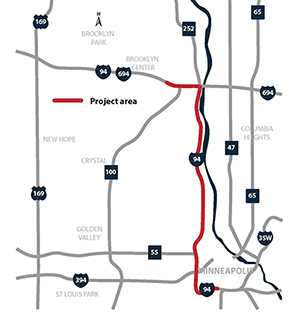
This map shows the area of the I-94 project between Minneapolis and Brooklyn Center. |
One of the busiest stretches of freeway in the Twin Cities is getting a makeover.
MnDOT started March 20 on a project that maintains and restores nine miles of Interstate 94 from Nicollet Avenue in Minneapolis to Shingle Creek Parkway in Brooklyn Center.
The road sees between 100,000 and 140,000 vehicles a day depending on where you are on the corridor. The corridor includes recognizable landmarks such as the Basilica of St. Mary, the Minneapolis Farmers Market and the Walker Art Center and serves as a key connector to downtown for those traveling from the northwest.
The $46.3 million project was awarded in February to PCI Roads of St. Michael.
The project is one of the most ambitious MnDOT has taken on recently. In addition to resurfacing nine miles of freeway, crews will make repairs to 50 bridges and all the ramps from Nicollet Avenue to Shingle Creek Parkway. It includes work inside the Lowry Hill Tunnel as crews will replace tile and make concrete repairs to the six lanes of freeway inside.
“I feel it’s one of the most fast-paced and complicated projects MnDOT has done in the metro,” project engineer Tim Nelson said. “We have a lot of improvements we are doing in a short period of time that requires many traffic changes throughout the year.”
MnDOT staff aggressively reached out to motorists and residents who drive through or live or work near the corridor. Staff conducted about 70 meetings with organizations and neighborhood groups and visited more than 300 businesses to inform them of the upcoming work.
An email list of 250 major players in the area gets regular updates on project changes. Those major players, which include school districts, downtown Minneapolis organizations, neighborhood associations, sports teams and property managers, help MNDOT spread the word about the project through their contact lists. This reaches thousands of people that MnDOT would have trouble reaching.
Watch this video to learn more about the work on I-94. Video produced by D.A. Bullock |
A postcard was mailed to 30,000 residents who live within six blocks of the corridor explaining the project and inviting them to check out the project web page and sign up for email alerts.
MnDOT staff pursued opportunities to reach mass audiences through free media by pitching stories for the newspapers and TV station stations in the region. Dozens of stories have appeared in papers, TV and the radio.
The complex project is frequently changing with ramps and lanes opening and closing on a weekly basis.
The freeway will be reduced to two lanes for much of 2017. Hwy 252 to I-94 east in Brooklyn Center was closed May 8 while the bridge deck on I-94 west is replaced. That part of the project is expected to take two months.
One side of the tunnel will be closed for about three months. That will shift traffic to other side with two lanes in each direction and a concrete barrier in the middle. Lanes will be reduced to 10 feet wide, requiring trucks that weigh more than 9,000 pounds to use alternate routes.
Much of the work should be done by Nov. 1, allowing all lanes and the tunnel to be open as preparations for Super Bowl 52 in Minneapolis ramp up. MnDOT expects to get another 12-15 years out of that stretch of the freeway with the completion of this project.
More information on the 1-94 project can be found on the project website.
|
 |
|

|
 |
TABLE of CONTENTS
 |
Seven MnDOT pilot projects aim high |
By Shannon Fiecke, Research Services
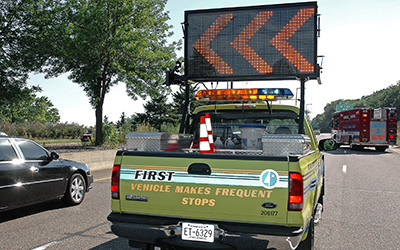
Some arrow message boards will be upgraded through a pilot project to transmit real-time notification of lane closures to traveler information services. Photo by David Gonzalez |
Roadside fencing that protects endangered turtles, a toolkit for identifying potentially acid-producing rock and a device that could save MnDOT $200 million a year in pavement damage are just a few of the advancements that MnDOT hopes to make in the near future, thanks to seven recently funded research implementation projects.
Each spring, the governing board for MnDOT’s research program funds initiatives that help put new technology or research advances into practice. This year’s picks aim to improve the environment, reporting of traffic signal data, notification of lane closures and the design and quality of pavements.
Here’s a brief look at the projects (full proposals here):
Protecting the Environment and Wildlife
- To avoid the leaching of potentially acid-generating rock during excavation projects, MnDOT hopes to develop a GIS-based risk-screening tool that identifies areas where PAG rock might be encountered. Guidance will be developed for identifying and handling PAG rock.
Found in bedrock throughout the state - especially northern Minnesota, PAG minerals can release acid upon contact with air or water, a danger to aquatic and human life.
“Anytime we dig, there is the potential to expose this stuff,” said Jason Richter, chief geologist.
- Reducing roadway access for small animals, including endangered turtles, is a priority for MnDOT and the Minnesota Department of Resources. MnDOT will analyze the effectiveness of different types of small animal exclusion fences tried across the state and develop a standard set of designs for future projects.
Improved Reporting of Traffic Signal Data
- A centralized hub of traffic signal data could benefit future vehicle-to-infrastructure (V2I) applications and assist with the modeling of transportation project impacts. Methods and tools will be developed for a regional database of intersection control information that extracts data from MnDOT’s recently acquired Central Traffic Signal Control System and soon-to-be adopted Signal Performance Measure application.
Real-Time Notice of Lane Closures
- In this pilot project, 20 MnDOT arrow board messages will be equipped with technology that automatically reports lane closures on 511 and highway message boards, providing more timely motorist notification.
Longer-Lasting Roads and Improved Quality Control
- This summer, a new quality assurance device called the Rolling Density Meter will be deployed on several pavement projects, eliminating the need for destructive sample cores.
“This is the ultimate in compaction control,” said Glenn Engstrom, Office of Materials and Road Research director. If contractors obtain the right level of density when paving asphalt roads, MnDOT could eliminate $200 million per year in premature road failure.
- In 2018, MnDOT plans to require Intelligent Compaction (a pavement roller technology that reduces workmanship issues) on all significant asphalt projects. A vehicle-mounted mobile imaging device will be piloted that collects necessary supportive roadway alignment data, without the need for survey crews.
- Upgrades to MnDOT’s pavement design software, MnPAVE, (incorporating recycled unbound and conventional base material properties) will help increase the service life of Minnesota roads.
Have a research need?
MnDOT is collecting ideas for its next funding cycle. The deadline is May 18.
|
|
 |
|

|
 |
TABLE of CONTENTS
 |
Creating a Customer-Centered Culture |
|
By Jocelyn Stein and AnneMarie Burgess, WIG 2.0 Team
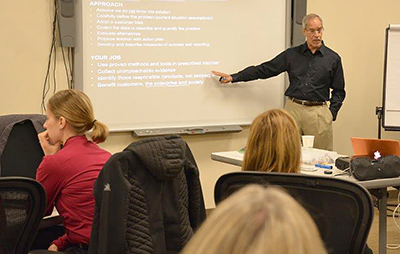
Rob Lawton leads a recent C3 training at Central Office in St. Paul. To date, Lawton has trained more than 150 MnDOT employees to use a more customer mindset in their daily work. Photo by Judy Jacobs |
Created by Robin Lawton, author of Mastering Excellence, Customer-Centered Culture is a system of principles and tools designed to support WIG 2.0 and serve as an additional way to challenge WIG 2.0 teams to look more closely, from a customer mindset, at the products they produce.
Since October 2016, more than 150 MnDOT senior leaders, WIG coaches and pilot project staff have elected to attend C3 training. The training teaches attendees how to use a customer viewpoint--versus a producer viewpoint--to help create a more customer-centered mindset.
Feedback from participants of the C3 training noted that creating a customer-centered culture means thinking differently about what, and how, products and services are provided. They learned that focus and experimentation on internal service products and processes create a good foundation for applying the philosophy and methods externally.
Draft definitions aligned with C3 are being adopted to help us better understand and prioritize our diverse customers’ needs. Employees have begun using these definitions to support WIG 2.0 in targeted areas to help define:
- Who are the end users of each of the products we deliver?
- What products do we produce?
- Do we know how customers think we are doing? How?
- What can we do to delight our customers?
- Do we have an actionable, ongoing feedback loop with customers?
- How might we better measure and track customer satisfaction and improvements?
The first phase of the project works to find out what the end users of a specific product want from that product and in what priority order. C3 asks us to focus on end user desired outcomes rather than on the process we use to create products. Participants were so interested in the approach that they have voluntarily decided to form C3 pilot project teams over the last six months to incorporate C3 concepts and make recommendations for improvement of targeted MnDOT products.
The pilot projects are a way for MnDOT to learn and apply new tools that can help better identify what and how to measure performance metrics from a customer perspective. If you are interested in learning more about C3 and want to be added to a waiting list for future workshops please email your request to: MN_DOT_WIG WIG.DOT@state.mn.us. |
 |
|

|
 |
TABLE of CONTENTS
 |
Agency holds first public engagement seminar to share information, successes in working with stakeholders |

(From left) Rebecca Arndt, District 7 public affairs coordinator, discusses stakeholder analysis with Anna Craig, credentials tech, and Ted Coulianos, supervisor, both from the Office of Freight and Commercial Vehicle Operations, during a breakout session. Photo by Chris Joyce |
Nearly 90 public affairs coordinators, project engineers, project managers, planners and other employees participated May 15 in MnDOT’s first public engagement seminar in St. Cloud.
Led by the Office of Public Engagement and Constituent Services staff, the seminar brought together some of MnDOT’s many employees who are involved in public engagement activities to share information across all levels of the agency and make participants more aware of available resources, current successful public engagement strategies and the overall importance of working with external stakeholders.
|
(Foreground) Terrina White, Office of Government Affairs legislative liaison, summarizes her groupís discussion of the roles in the public engagement process. Behind her, from left, are Jerimiah Moerke, District 4 public affairs coordinator; Tom Styrbicki, Office of Project Management and Technical Support director; Ben Lowndes, Conflict Assessment & Management Program coordinator, and Beth Petrowske, District 1 public affairs coordinator. Photo by Chris Joyce |
The daylong session covered pre-engagement planning, customer response management, post-engagement conflict resolution, and everything in-between.
PECS director Richard Davis highlighted several successful public engagement efforts, including District 8’s attention to the growing Somali and Spanish-speaking populations in the Willmar area, District 1’s response to senior citizens experiencing Hibbing’s first roundabout, and the growing outreach of MnDOT’s Science Technology Engineering and Math program.
“We have wonderful people doing wonderful work engaging the public,” Davis said. “Putting the ‘who’ and the ‘why’ first works.”
Go to iHUB for more information about public engagement. |
 |
|

|
 |
TABLE of CONTENTS
 |
MnDOT bicyclists compete in National Bike Challenge |
|
By Sue Roe
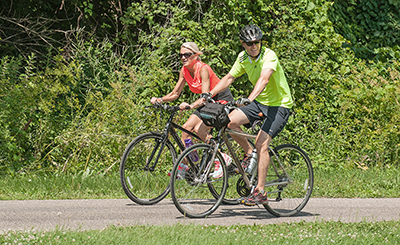
The 2017 National Bicycle Challenge is now underway and employees can still join the MnDOT teams to track their miles ridden. The challenge is to encourage people of all skill levels to bicycle more often. Photo by David Gonzalez |
Employees who like to bicycle are invited to join the MnDOT teams participating in the 2017 National Bike Challenge. The challenge runs from May 1 to Sept. 30 and employees can sign up at any time.
So far, 11 employees are tracking their miles ridden and logging them into the challenge website. Bicyclists are ranked within their own groups and in the nation.
Luke Van Santen, one of the participants, said the challenge is for bicyclists of all skill levels.
“It doesn’t matter if you ride your bike to work or just near your home. The challenge is to encourage people to bicycle and it uses teams to have fun by keeping track of their miles,” he said. “It’s a free and easy way to motivate yourself, your coworkers and your community.”
Van Santen, who has been part of the challenge for the past few years, is joined by other MnDOT employees Ben Crow, Amber Dallman, A.M. Staples, Mike Sonn, Liz Walton, Jim DeLuca, Dave Cowan, Eric Davis, Michael Petesch and Mike Schadauer.
Van Santen, Schadauer and Petesch are currently in the top three spots for riding the most miles on the team.
MnDOT is also part of the State of Minnesota Employees Team.
The bike challenge began in 2009 when the Kimberly-Clark Corporation created a challenge for its 50,000 employees. It was piloted in Wisconsin and expanded nationally in 2012 under the direction of the League of American Bicyclists.
The national goal is for 50,000 riders to pedal more than 30 million miles. Bicyclists are eligible for monthly prize drawings and award winners will be named at the end of the challenge.
To join, go to www.nationalbikechallenge.org/join |
 |
|

|
 |
TABLE of CONTENTS
 |
Whatís new on the web |
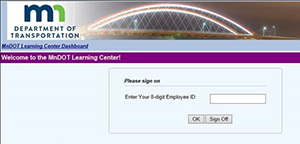
New updates to the Learning Center will go on-line May 30. |
Learning Centers update
The Learning Centers will be upgrading to 6.11 features and will be unavailable from Friday, May 26 until Tuesday, May 30. Employees must be logged out of all Learning Centers before 1 p.m. on May 26. Any eLearning started and not completed before 1 p.m. will be lost if students have not logged out prior to this time.
When the Learning Centers are back on-line May 26, look for the following improvements:
- An online tutorial is available 6.11 Learning Center to introduce you to the new 6.11 features.
- A new dashboard screen designed for employees has been added to the Pathlore Learning Center. This screen is designed to give MnDOT employees an overview of their training status and other activities with the Learning Center.
- The Training Plan screen in the Learning Center has been redesigned to provide MnDOT employees with more intuitive access to their assigned training. The interface is clean and modern and shows only the information needed by default, while still allowing full access to courses on their plan.
- The Learning Center has been enhanced to add popup menus into the title bar at the top of each page. These menus allow the functionality of Learning Center to be quickly accessed from any page, without having to return to a specific menu page first.
- The data for the Student Dashboard is cached on the server to make it quicker to access. It is refreshed automatically after certain events, such as completing an online course, so that it should remain accurate most of the time.
- A message is displayed at the top of the page indicating the date and time at which the currently displayed data was generated. There is also a Refresh link available next to this message. Clicking the refresh link causes the dashboard data to be generated again and redisplayed, thus taking into account all current training data for the user.
- The Manager Center will have a separate tutorial that will be available when the new site is back on.
For questions about this upgrade, please contact the Learning Center Helpdesk: or phone: 651-366-3414. |
 |
|

|
 |
TABLE of CONTENTS
 |
ESGR presents MnDOT with a Pro Patria Award |
By Rich Kemp
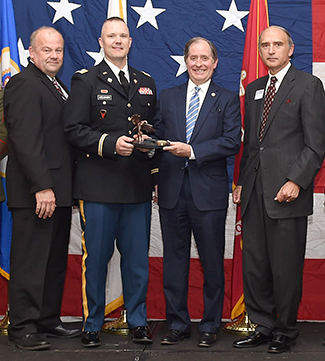
From left, Craig Collison, District 2 engineer; TJ Melcher, District 2 public affairs coordinator; and Commissioner Charlie Zelle received an ESGR Pro Patria Award from Nick Ostapenko, ESGR state chair. Photo by Paul Santikko, Minnesota National Guard |
The Minnesota Employer Support of the Guard and Reserve state committee presented MnDOT with a Pro Patria Award at their annual awards ceremony May 8 in Bloomington.
Each ESGR state committee awards the Pro Patria to one small, one large, and one public sector employer in their state or territory. Recipients have demonstrated the greatest support to Guard and Reserve employees through their leadership and practices, including adopting personnel policies that make it easier for employees to participate in the National Guard and Reserve. This is the highest level of award at the State level.
MnDOT is also one of only 30 finalists nation-wide for the Department of Defense’s highest employer award, the Secretary of Defense Employer Support Freedom Award.
The Secretary of Defense Employer Support Freedom Award is the highest recognition given by the U.S. Government to employers for their support of their employees who serve in the Guard and Reserve. The 30 finalists were selected from 3,064 nominations submitted by Guardsmen and Reservists. The group represents large and small employers from almost every industry, as well as from state and local governments.
Nominations must come from a Guard or Reserve member who is employed by the organization they are nominating, or from a family member. TJ Melcher, District 2 public affairs coordinator, nominated MnDOT for the Freedom Award.
“I work in a one-man department so there is no one else to fill in for me,” said Melcher. “I report directly to District Engineer Craig Collison and he never once made me feel as though my absence would be a burden on him. We worked together on my needs, and also on hiring a temporary worker to hold the position for while I was deployed. In talking with other service members within the department, each one would share the same sentiment and that is why I nominated MnDOT for the Secretary of Defense Employer Support Freedom Award.”
The ESGR awards program allows members of the guard and reserve the opportunity to nominate their employer to be recognized as those who go above and beyond in their support of the military. Employers who have been honored with the Above and Beyond Award, who have had at least one supervisor or other representative honored with a Patriot Award, and who have signed a Statement of Support are eligible for the Pro Patria Award.
Almost one-half of the U.S. military is comprised of the Guard and Reserve. The Department of Defense shares these citizen warriors with their civilian employers, many of whom provide significant support to their employees who serve in the Guard and Reserve. This award recognizes employers who provide the most outstanding support for their Guard and Reserve employees and is presented annually by the Secretary of Defense.
MnDOT has received other ESGR awards in the past.
In 2013, MnDOT received an Above and Beyond award for the support Thomas Mitchell, a hydrologist for the Metro District, received from his co-workers and his supervisor, Brian Kelly, during Mitchell’s military duty.
District 2 received an ESGR Above and Beyond award in 2016 for the districts support of military members.
The Department of Defense will announce the winner of the Freedom Award in June. |
 |
|

|
|

|
 |
TABLE of CONTENTS
 |
Efforts to advance women in transportation recognized |
By Dana Hernandez

Commissioner Charlie Zelle receives the Rosa Parks Diversity Leadership Award on behalf of MnDOT during WTSís Scholarships and Recognition Luncheon. Photo courtesy of WTS |
MnDOT won two awards during Women’s Transportation Seminar’s annual Scholarships and Recognition Luncheon in April.
The agency was the recipient of The Rosa Parks Diversity Leadership Award and Philip Schaffner received the Honorable Ray LaHood Award.
WTS presents awards to individuals, groups or organizations that support their mission of advancing women in transportation.
The Rosa Parks Diversity Leadership Award recognizes significant contributions in promoting diversity and cultural awareness within an organization, the transportation industry, or in a project or activity.
MnDOT received this award for significant efforts to address “equity and inclusion in state-wide transportation planning.” The agency’s work in public engagement to collect input and its drive to create an equal workforce is shown through the Bicycle System Plan, Minnesota Walks, the Statewide Multimodal Transportation Plan, the Transit Plan and the Minnesota State Highway Investment Plan. MnDOT’s WIG initiatives have also brought trust and transparency to the forefront when serving customers internally and within the industry state-wide.
The Honorable Ray LaHood Award recognizes men who are transportation leaders and “have made outstanding contributions towards the advancement of women and minorities,” according to the WTS website.

Philip Schaffner received the Honorable Ray LaHood Award during WTSís Scholarships and Recognition Luncheon. Photo courtesy of WTS |
Philip Schaffner, policy planning director in the Office of Transportation System Management, received this award because he “creates opportunities for and contributes to the reputation and credibility of women and minorities within transportation.” Schaffner supports their advancement within the industry by leading a team that aims to increase diversity within the workforce, demonstrates the prioritization of diversity when hiring and actively advocates for the inclusion of women and minorities on professional panels and at conferences and events. Schaffner is also a co-founder of MnDOT’s planning internship program that develops a diverse group of experienced professionals.
Each year, WTS announces award winners who pursue transportation “excellence through the achievement and success of women.” |
 |
|
| |
|



